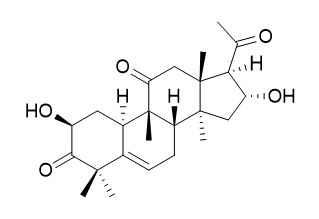Hexanorcucurbitacin D
Hexanorcucurbitacin D is a weak agonist acting at the ecdysteroid receptor.
Inquire / Order:
manager@chemfaces.com
Technical Inquiries:
service@chemfaces.com
Tel:
+86-27-84237783
Fax:
+86-27-84254680
Address:
1 Building, No. 83, CheCheng Rd., Wuhan Economic and Technological Development Zone, Wuhan, Hubei 430056, PRC
Providing storage is as stated on the product vial and the vial is kept tightly sealed, the product can be stored for up to
24 months(2-8C).
Wherever possible, you should prepare and use solutions on the same day. However, if you need to make up stock solutions in advance, we recommend that you store the solution as aliquots in tightly sealed vials at -20C. Generally, these will be useable for up to two weeks. Before use, and prior to opening the vial we recommend that you allow your product to equilibrate to room temperature for at least 1 hour.
Need more advice on solubility, usage and handling? Please email to: service@chemfaces.com
The packaging of the product may have turned upside down during transportation, resulting in the natural compounds adhering to the neck or cap of the vial. take the vial out of its packaging and gently shake to let the compounds fall to the bottom of the vial. for liquid products, centrifuge at 200-500 RPM to gather the liquid at the bottom of the vial. try to avoid loss or contamination during handling.
Evid Based Complement Alternat Med.2021, 8855980.
Curr Issues Mol Biol.2024, 46(6):6018-6040.
Molecules.2021, 26(9):2802.
Agronomy 2021, 11(3),502.
Antioxidants (Basel).2023, 12(12):2131.
iScience.2024, 27(8):110496.
Int J Mol Sci.2023, 24(22):16465.
Molecules.2017, 22(3)
Sci Rep. 2018, 462(8)
J of Food Quality2020, 8851285.
Related and Featured Products
Chem Pharm Bull (Tokyo). 2010 May;58(5):747-51.
Cucurbitane-type triterpenes with anti-proliferative effects on U937 cells from an egyptian natural medicine, Bryonia cretica: structures of new triterpene glycosides, bryoniaosides A and B.[Pubmed:
20460809]
The 90% aqueous ethanol extract of an Egyptian natural medicine, the roots of Bryonia cretica L., was found to exhibit a strong inhibitory effect on the proliferation of human leukemia U937 cells.
METHODS AND RESULTS:
By bioassay-guided fractionation, we isolated two new cucurbitane-type triterpene glycosides, bryoniaosides A and B, were isolated from the roots of Bryonia cretica L. together with 16 known cucurbitane-type triterpenes and glycosides. The chemical structures of bryoniaosides A and B were determined on the basis of chemical and spectroscopic evidence. Effects of principal cucurbitane-type triterpenes (cucurbitacins B, D, E, and J, 23,24-dihydrocucurbitacins B and E, and Hexanorcucurbitacin D) on proliferation of the cells were examined.
CONCLUSIONS:
Cucurbitacins B and E showed the greater cytotoxic effects with IC(50) values of 9.2 and 16 nM after 72 h, and their IC(50) values were equivalent to that of camptothecin.
An alpha,beta-conjugated ketone moiety at the 22-24-positions and an acetoxy group at the 25-position are essential for the strong activity.
Biochem J. 1997 Nov 1;327 ( Pt 3):643-50.
Cucurbitacins are insect steroid hormone antagonists acting at the ecdysteroid receptor.[Pubmed:
9581538 ]
METHODS AND RESULTS:
Two triterpenoids, cucurbitacins B and D, have been isolated from seeds of Iberis umbellata (Cruciferae) and shown to be responsible for the antagonistic activity of a methanolic extract of this species in preventing the 20-hydroxyecdysone (20E)-induced morphological changes in the Drosophila melanogaster BII permanent cell line. With a 20E concentration of 50 nM, cucurbitacins B and D give 50% responses at 1.5 and 10 microM respectively. Both cucurbitacins are able to displace specifically bound radiolabelled 25-deoxy-20-hydroxyecdysone (ponasterone A) from a cell-free preparation of the BII cells containing ecdysteroid receptors. The Kd values for cucurbitacins B and D (5 and 50 microM respectively) are similar to the concentrations required to antagonize 20E activity with whole cells. Cucurbitacin B (cucB) prevents stimulation by 20E of an ecdysteroid-responsive reporter gene in a transfection assay. CucB also prevents the formation of the Drosophila ecdysteroid receptor/Ultraspiracle/20E complex with the hsp27 ecdysteroid response element as demonstrated by gel-shift assay. This is therefore the first definitive evidence for the existence of antagonists acting at the ecdysteroid receptor.
CONCLUSIONS:
Preliminary structure/activity studies indicate the importance of the Delta23-22-oxo functional grouping in the side chain for antagonistic activity. Hexanorcucurbitacin D, which lacks carbon atoms C-22 to C-27, is found to be a weak agonist rather than an antagonist. Moreover, the side chain analogue 5-methylhex-3-en-2-one possesses weak antagonistic activity.
Carasiphenol C
Catalog No: CFN95045
CAS No: 868168-04-1
Price: $368/5mg
6''-O-Acetylsaikosaponin D
Catalog No: CFN95090
CAS No: 64340-45-0
Price: $288/5mg
1,3,6-Trihydroxy-2-methylanthraquinone 3-O-(6'-O-acetyl)-alpha-L-rhamnosyl-(1->2)-Beta-D-glucoside
Catalog No: CFN95095
CAS No: 87686-87-1
Price: $218/10mg
3,7,25-Trihydroxycucurbita-5,23-dien-19-al
Catalog No: CFN95150
CAS No: 85372-65-2
Price: $318/5mg
(3E,5E,11E)-tridecatriene-7,9-diyne-1,2-diacetate
Catalog No: CFN95191
CAS No: 94753-06-7
Price: $318/5mg
3-Hydroxy-4',5-dimethoxystilbene
Catalog No: CFN95199
CAS No: 58436-29-6
Price: $318/10mg
Cannabisin B
Catalog No: CFN95268
CAS No: 144506-17-2
Price: $413/5mg
Glaucoside A
Catalog No: CFN95299
CAS No: 81474-91-1
Price: $318/5mg
Tumulosic acid
Catalog No: CFN95399
CAS No: 508-24-7
Price: $368/5mg
Naringenin 7-O-gentiobioside
Catalog No: CFN95435
CAS No: 104154-33-8
Price: $368/5mg



